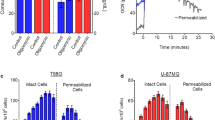Abstract
The primary mechanism of cyanide (CN) intoxication is the inhibition of metabolism in the central nervous system. We determined the effects of CN on several biochemical processes in neuroblastoma x glioma hybrid NG108-15 cells, which possess numerous neuronal properties. These cells were not sensitive to a high concentration (1 mM) of NaCN, but became sensitive in the presence of the anaerobic glycolysis inhibitors sodium iodoacetate (IA) and 2-deoxyglucose (2-DG): cellular metabolic processes (e.g., DNA, RNA and protein synthesis) decreased, to about 40% of control due to treatment with 0.5 mM NaCN+0.05 mM IA and 0.1 mM NaCN+20 mM 2-DG. ATP in cells exposed to 0.01 or 0.1 mM NaCN+20 mM 2-DG was reduced 75% and 100%, respectively within one min. Pretreatment of cells with the CN antidote cobalt (II) chloride (CoCl2) (0.06–0.18 mM) for 5 min prevented the depression of both [3H]leucine incorporation and ATP synthesis due to 1 mM NaCN+20 mM 2-DG in a concentration-dependent manner. A proposed CN antidote alpha-ketoglutaric acid (disodium salt) also prevented the depression of cellular metabolism due to NaCN plus 2-DG. These results indicate that blocking anaerobic glycolysis makes NG108-15 cells sensitive to a low concentration of CN. Thus NG108-15 cells should be useful to study the mechanisms of neurotoxicity of CN and to test antidotes.
Similar content being viewed by others
References
Lumsden, C. E. 1970. Pathogenic mechanisms in the Leucoencephalopathies in anoxic-ischemic processesin disorders of the blood and in intoxications, Pages 572–663, in Vinken, P. J., and Bruyn G. W., (eds.),Handbook of Clinical Neurology, Vol. 9 North-Holland Publishing Co., Amsterdam.
Way, J. L. 1984. Cyanide intoxication and its mechanism of antagonism. Ann. Rev. Pharmacol. Toxicol. 24:451–481.
Ballantyne, B. and Marrs, T. C. 1987. Post-mortem features and criteria for the diagnosis of acute lethal cyanide poisoning. Pages 217–247,in B. Ballantyne and T. C. Marrs, (ed.), Clinical and Experimental Toxicology of Cyanides Wright, Bristol.
Keilin, D. 1930. Cytochrome and intracellular oxidase. Proc. R. Soc. (London) 106:418–444.
Warburg, O. 1931. Uber nicht-hemmung der zellat-mung durch blausaure. Biochem. z. 231:493–497.
Isom, G. E. and Way, J. L. 1984. Effects of oxygen on the antagonism of cyanide intoxication: cytochrome oxidase, In Vitro. Toxicol. and Appl. Pharmacol. 74:57–62.
Egekeze, J. O., and Oehme, F. W. 1980. Cyanides and their toxicity: A literature review. Vet. Quart. 2:104–114.
Ballantyne, B. 1983. Artifacts in the definition of toxicity by cyanides and cyanogens. Fundam. Appl. Toxicol. 3:400–408.
Ballantyne, B. 1987. Toxicology of cyanide. Pages 41–126,in B. Ballantyne and T. C. Marrs, (eds.), Clinical and Experimental Toxicology of cyanides Wright, Bristol.
Baskin, S. I., Wilkerson, K. A., and Blitstein, 1987. Cardiac effects of cyanide Pages 138–155in B. Ballantyne and T. C. Marrs, (eds.), Clinical and Experimental toxicology of cyanides. Wright, Bristol.
Dean, R. T. 1987. Some critical membrane eyents during mammalian cell death,in C. S. Potten, (ed.), Perspective of Mammalian cell death, Oxford University Press, New York.
Kurzinger, K., Stadtkus, C., and Hamprecht, B. 1980. Uptake and energy-dependent extrusion of calcium in neural cells in culture. Eur. J. Biochem. 103:597–611.
Wakade, A. R. and Wakade, T. D. 1985. Sympathetic neurones grown in culture generate ATP by glycolysis: Correlation between ATP content and [3H]norepinephrine uptake and storage. Brain Res. 359:397–401.
Hamprecht, B. 1977. Structural, electrophysiological, biochemical, and pharmacological properties of neuroblastoma-glioma cell hybrids in cell culture. Pages 99–170in Bourne, G. H., Danielli, J. F., and Leon, K. W., (eds.), Int. Rev. of Cyt.b Vol 49. Academic Press, New York.
Nathanson, N. M., Klein, W. L., and Nirenberg, M. 1978. Regulation of adenylate cyclase activity mediated by muscarinic acetylcholine receptors. Proc. Acad. Sci. USA. 75:1788–1791.
Rojas, E. R., Santos, R. M., Stutzin, A., and Pollard, H. B. 1986 Pages 163–178,in Latorere, R., (ed), Ionic Channels in Cell and Model Systems, Plenum Publishing Corp., New York.
Isom, G. E., and Way, J. L. 1973. Cyanide intoxication: Protection with cobaltous chloride. Toxicol. and Appl. Pharmacol. 24:449–456.
Gee, S. J., LeValley, S. E. and Tyson, C. A. 1987. Application of a Hepatocyte-Erythrocyte coincubation System to Studies of Cyanide Antidotal mechanisms. Toxicol. and Appl. Pharmacol. 88:24–34.
Norris, J. C., and Hume, A. S. 1986. Structure activity relationship of Keto acids in antagonizing cyanide-induced lethality. Fed. Proc. 45:916 [Abstract].
Yamamoto, H. A. 1989. Hyperammonemia, increased brain neutral and aromatic amino acid levels, and encephalopathy induced by cyanide in mice. Toxicol. and Appl. Pharmacol. 99:415–420.
Maduh, E. U., Johnson, B. K., Borowitz, J. L., and Isom, G. E. 1988. Cyanide-induced Neurotoxicity: Mechanisms of Attenuation by chloropromazine. Toxicol. and Appl. Pharmacol. 96:60–67.
Author information
Authors and Affiliations
Rights and permissions
About this article
Cite this article
Ray, P., Monroe, F.L., Berman, J.D. et al. Cyanide sensitive and insensitive bioenergetics in a clonal neuroblastoma x glioma hybrid cell line. Neurochem Res 16, 1121–1124 (1991). https://doi.org/10.1007/BF00966589
Accepted:
Issue Date:
DOI: https://doi.org/10.1007/BF00966589




